
If you’re enough into watches to be reading this, you most likely already know the deep ties between Omega and NASA, in particular when it comes to the Moon. This has been very much documented, and recommended reading on the matter is provided further below. Here, we’ll be focusing on the Lunar Module replica outside Omega HQ, and why it matters so much in Omega history.
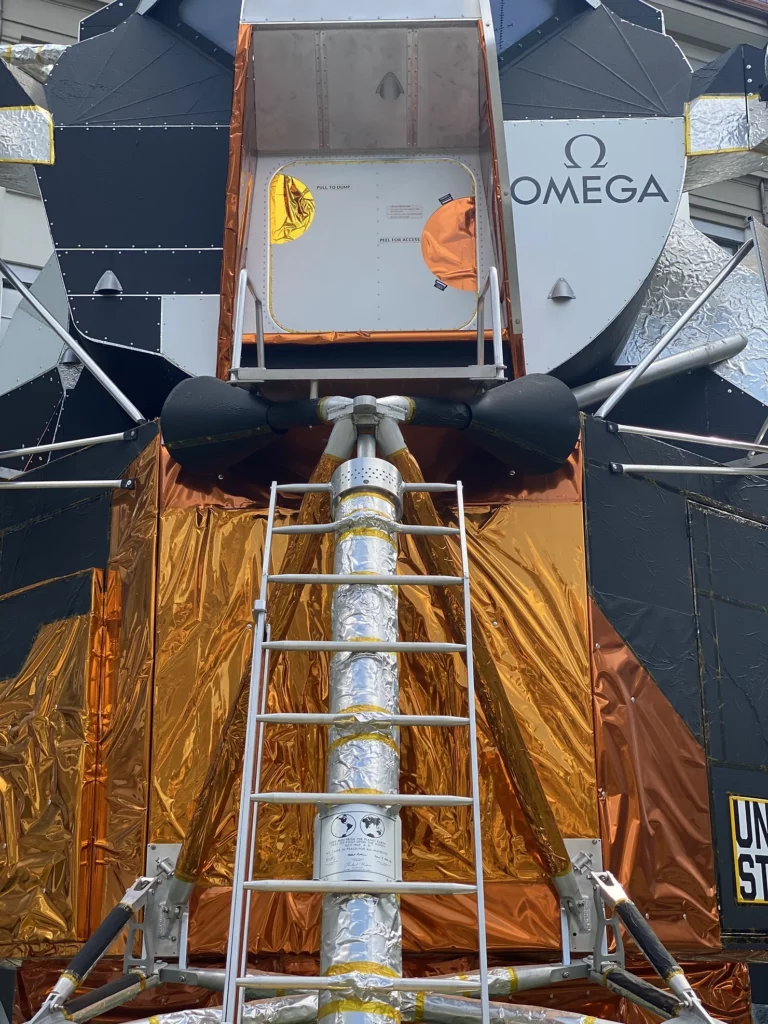
A Brief Recap of Omega and NASA Collaboration
No suspense here: it’s all about the Speedmaster. Launched in 1957, the first chronograph with a tachymeter on the bezel was initially designed for car racing. It was adopted, off-the-shelf, by several NASA members soon after. The Speedy then became the official watch for the Apollo program, launched in 1963, after having been first worn in space the year before. The now legendary timepiece successfully performed against watches supplied by other companies including Rolex and Longines during a series of tests measuring its adequacy for both intra and extra vehicular activities in the rough spacial environment. The watch was notoriously worn by Ed White, the first American to walk in space, during his 1965 Gemini 4 Spacewalk.
One noteworthy characteristic of the Speedmaster is that, unlike pretty much everything else NASA took into space, it was not custom-made to NASA specs, but rather used in its public, “civilian” version. According to some accounts, the introduction of crown guards, in 1965, to better protect not only the crown but also the pushers, was at NASA’s request. However, this topic is subject to fierce debate among collectors, as this forum thread illustrates. Regardless of its origin, the introduction of the crown guards is significant because it is what distinguished the watch as the “Professional” variant of the manually wound chronograph. Its first version, the 105.012, housing the legendary 321 movement to be replaced in the following generation, produced until 1968, is what Buzz Aldrin wore on the Moon.
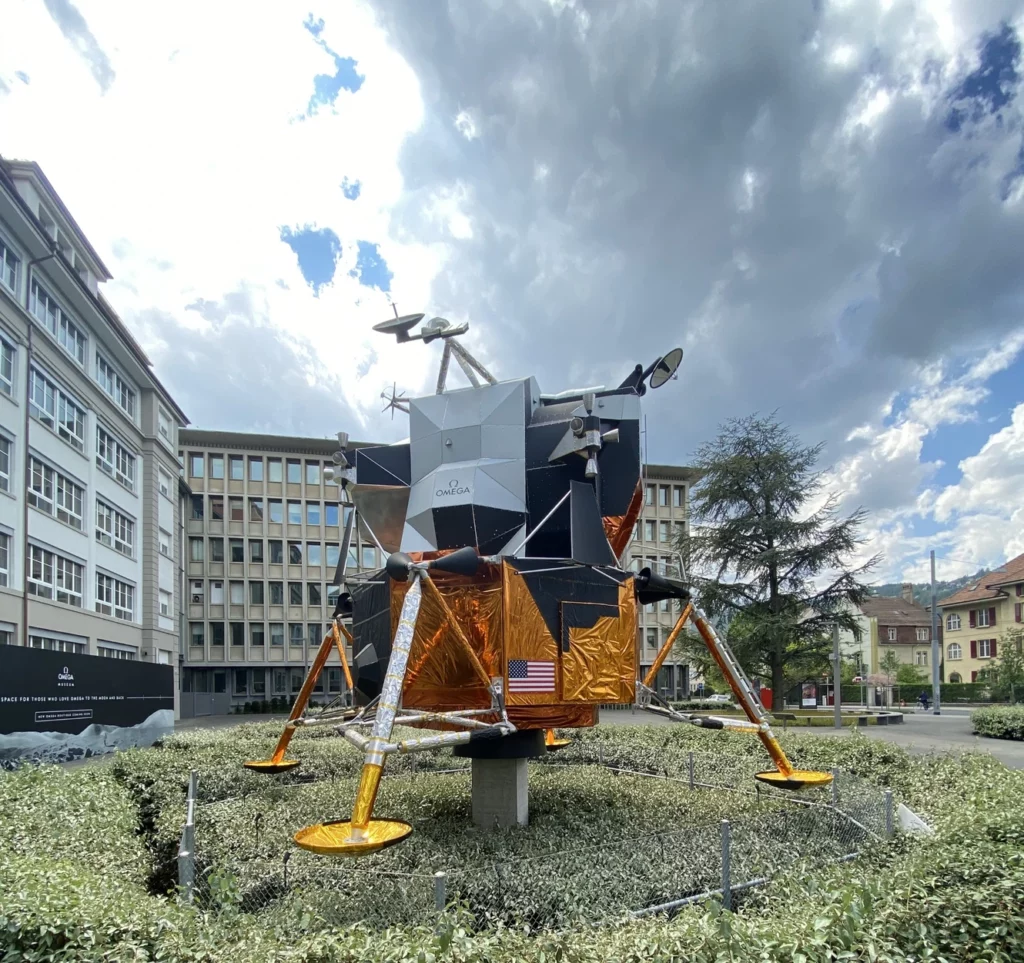
The Lunar Module
The LM is the component of Apollo missions that was designed specifically to land on the Moon, which it successfully did on six occasions. It was a “disposable” item, in the sense that it was not capable, by design, of flying back into the Earth’s atmosphere. After serving its purpose of landing two astronauts on the Moon, from lunar orbit, while the third stayed in the Command Module, and then being used as a launch pad during the ascent phase from the Moon, it would subsequently be abandoned into lunar orbit.
The LM is small, at about 7 meters high, and was known to be particularly crammed for the astronauts, who shared just over 4 meters in diameter of space. There was no seating position, and they used removable hammocks to sleep. Despite its unimpressive dimensions, the Lunar Module is a very intriguing, and incredibly neat looking piece of equipment with, obviously, unique history. While the actual LMs used for space travel are forever gone, having burnt in the atmosphere, there is one actual unit that is still with us: built for a second test flight eventually deemed unnecessary, LM-2 is displayed at the Smithsonian’s National Air & Space Museum in Washington D.C.
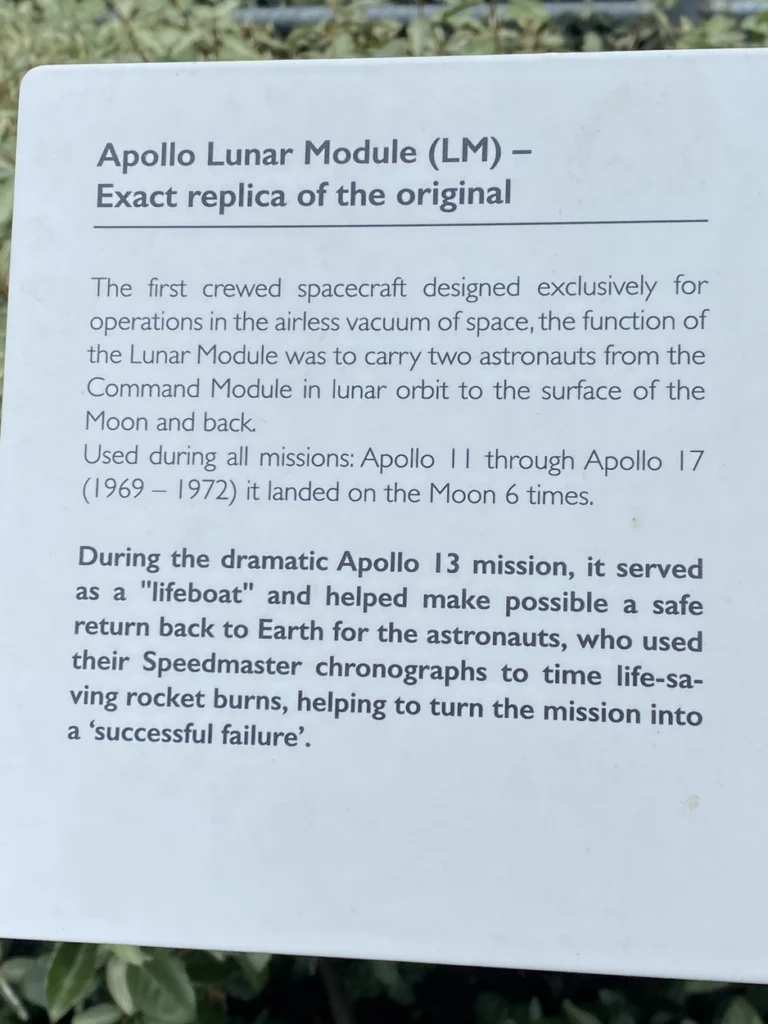
The Omega Full-Size Replica
Before we go into why the Lunar Module is of such significance from an Omega standpoint, let’s briefly talk about some of the specificities of its full size replica outside HQ. It was set up in 2019 as part of the new Omega building, also hosting its Museum. Coincidentally, 2019 also marked the 50 years of the landing on the Moon. I was fairly surprised to not find more information about the replica itself online, such as its technical specificities (material, weight) or construction process. If anyone has additional information, I would be very grateful if you shared it in the comment section. According to a thread on Omega Forums, it was built by the Dutch company Hal 3 Projects, specialised in space exploration equipment modelisation used for planning and training purposes. The construction is described by Omega as an “exact replica” (minus, obviously, the Omega logos…), as you can see in the pics above.
I must admit that the first time I saw the replica outside Omega, I thought it looked neat… but also a bit like a toy. Surely, the real LM could not have such a simplistic, almost fragile appearance? The external coating in particular seems at first glance like it’s straight out of a 1980s high school science project. But actually, upon subsequently paying closer attention to the Lunar Module in photos and documentaries from the Apollo days, it’s super realistic. I think it’s what looks to the novice, such as myself, as aluminium foil wrapping that gives it such an unassuming appearance. As I later found out, it’s not aluminium foil, but rather an insulation control blanket with multiple layers made of aluminised kaptan and mylar film. The coating’s role is to protect the vehicle from the sun’s heat.
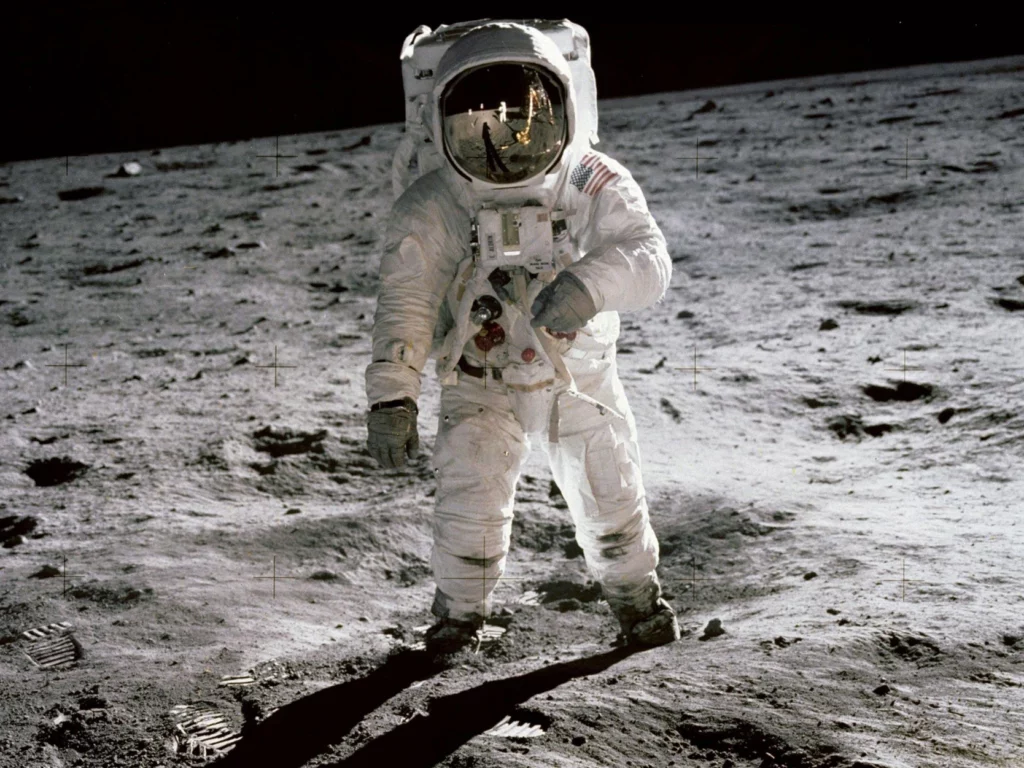

Omega, the LM and Apollo 13
Let’s first start with a quick recap of the basics. Famously described as a “successful failure”, the Apollo 13 mission could have ended up tragically after an oxygen tank exploded, preventing the Command Module, the core vehicle for the journey, from adequately hosting the astronauts. The three men then found refuge in the Lunar Module, despite it only being designed for use within the Moon’s orbit. Moreover, the LM was meant for two people over two days, not three people over four days. After some drastic cuts to its power consumption, including heat and the onboard clock, and some clever ad hoc engineering to make the square CO2 filters from the command module fit into the Lunar Module‘s sockets designed for round ones, it is the home that saved the three astronauts from ending their life in space.
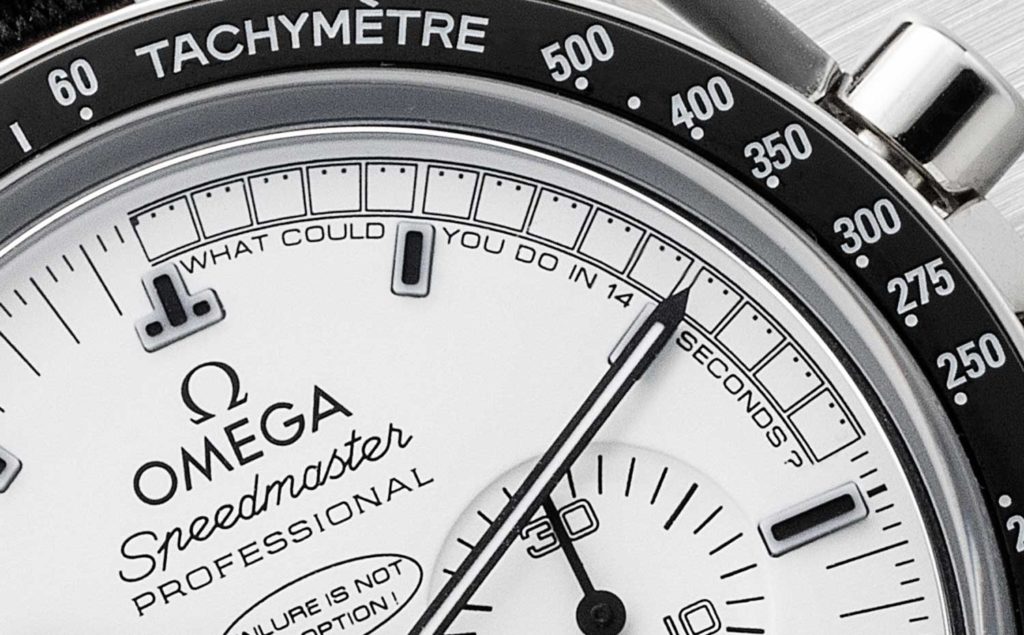
The role the Speedmaster played on Apollo 13 was more critical than on any other NASA mission. In order to correct the trajectory coming back into the Earth’s atmosphere, and avoid being bounced back into space, the ship had to perform a course correction by manually burning the LM’s fuel. As the clock on board was no longer working, Command Module Pilot Jack Swigert used his Speedy to time the manoeuvre for 14 seconds. This episode has led to significant, and totally justified, marketing from Omega, including the launch in 2003 and 2015 of Snoopy limited edition Speedmasters. Why Snoopy? The Silver Snoopy Award, by which NASA recognises outstanding achievements from its suppliers, was received by Omega after the Apollo 13 crew returned safely. On the 2015 edition, celebrating the 45th anniversary of the mission, the first 14 seconds are highlighted on the dial’s outer ring and the now famous slogan: “What could you do in 14 seconds?”
For anyone aware of the famous 14 seconds moment, the manual burn scene in the Ron Howard Apollo 13 movie can be quite surprising Why does Commander Jim Lovell, aka Tom Hanks, ask Jack Swigert to time 39 seconds and not 14? The main explanation is that there were actually multiple manual burns performed during the return journey onboard the LM. In the image further above taken in front of Omega’s replica, the explanatory text on the plaque mentions “live-saving rocket burns”, in the plural. The text on the Omega site page for the Apollo 13 Speedmaster equally refers to 14 seconds as “the amount of time it took the Apollo 13 astronauts to perform one of the smaller mid-course corrections”. Indeed, several corrections had to be made, and we can easily understand why Omega focused on the shortest one: not only does it make for a more aesthetic dial decoration but, more importantly, the precision of the timepiece obviously comes more into play the shorter the duration of the timing. Inversely, for the movie director, 14 seconds is too short to build up the dramatic intensity of the scene, and choosing a burn with a longer duration makes sense. For those interested in digging further into this topic, here is a short Reddit thread with useful links to transcripts and other logs.
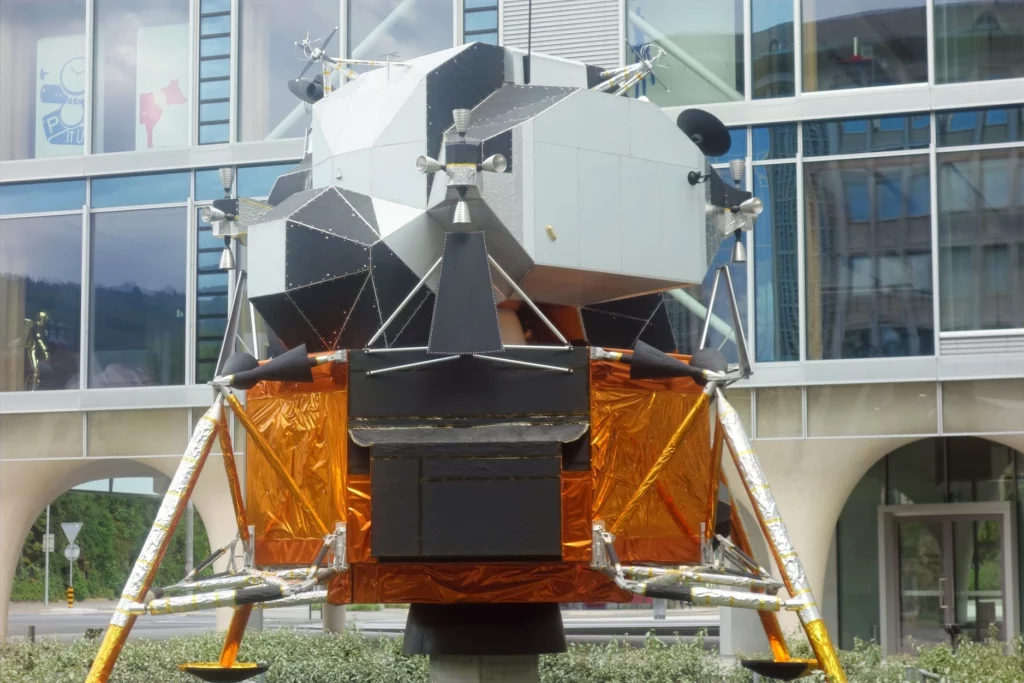
Visiting
The replica is just outside the HQ, near the Museum. You really can’t miss it. The address is Rue Jakob-Stämplfi 96. Because the replica is outdoors, it is accessible at any time, and on any day. That said, while it is certainly neat and worth taking a close look at, it only really makes sense as part of a broader visit including also the Museum, a stroll around the HQ’s buildings, and the Omega boutique right next to the LM replica. Tips on visiting those can be found here.
References
On top of the links already included above, I once again relied on several great articles found online. Below are the links to the ones I most recommend reading if you’re interested in going deeper.




In fact, it was June 1, 1965 when NASA published its letter of certification and the Omega Speedmaster became the official flight-qualified chronograph for all NASA manned spaceflight missions.
Three Mercury-era astronauts alread owned an Omega Speedmaster in 1962:
Donald Deke Slayton, Walter Schirra and Gordon Cooper. The latter two wore their personal CK2998 during their respective Mercury flights in October 1962 and May 1963.
More at Moonwatch Universe
Brilliant! Thank you so much for this very relevant and precise additional information.